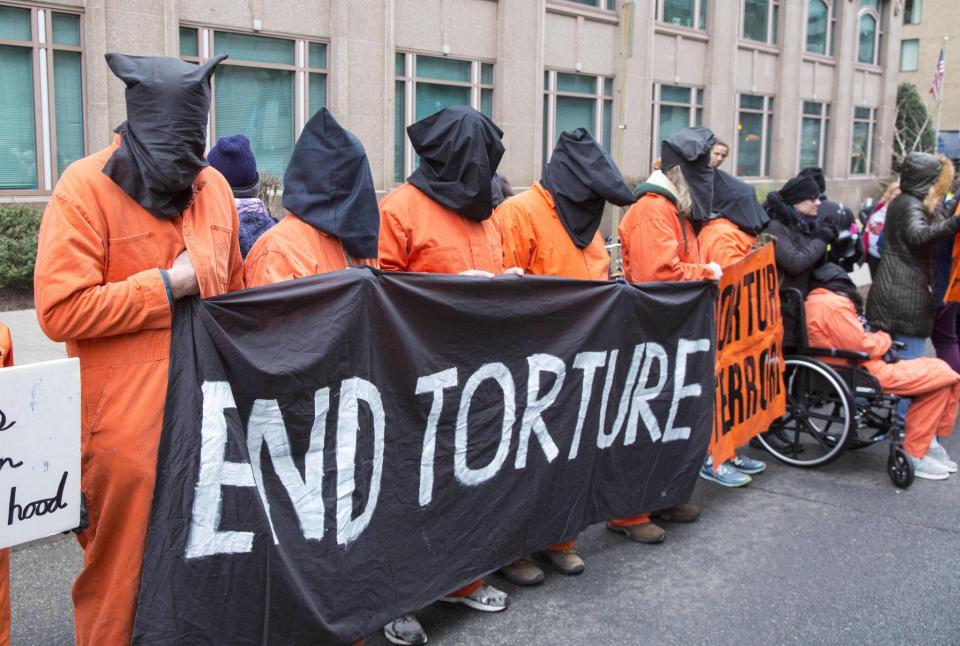What is ‘legal’ torture and how many countries still use it?

Donald Trump has provoked new fury by seeming to suggest that there are times when torture should legitimately be used against prisoners.
The new President told ABC News that he “absolutely” believes that torture works, adding that the US should “fight fire with fire” while interrogating ISIS terrorists.
His comments sparked a debate on whether America should re-introduce techniques like waterboarding to extract vital information.
However, the U.N. Convention Against Torture came into force in 1987 and 156 countries – virtually every country on the planet – has signed it.
The treaty aims to prevent torture and other acts of cruel, inhuman, or degrading treatment or punishment around the world, as well as forbidding states to transport people to other parts of the world if they believe they will be tortured.However, a 2014 report by Amnesty International claims that there are still as many as 141 countries that still torture citizens and prisoners.
That figure represents a staggering three quarters of the world where torture is still used, despite breaking the U.N. treaty.
Indeed, the United States is believed to torture prisoners themselves in various secret CIA ‘black sites’ that are in operation throughout the globe.
But while the treaty forbids torture, and the Geneva Convention outlawed acts of torture towards prisoners of war, Amnesty International still maintain that some countries are breaking international law in secret.
The organisation stated that there were 27 categories of torture reported in 2013/2014, including electric shocks, mock executions, water torture, the pulling of teeth – and rape and sexual violence.
Former CIA director George Tenet said in 2007 that the agency had prevented terror plots against the U.S. and saved countless lives by their rendition programme.
Manfred Nowak, the former U.N. Special Rapporteur on Torture, told Al Jazeera that America decided that torture was necessary in a post-9/11 world – and opened the door for other countries to use any means necessary to extract information from terror suspects in the national interest.
In that regard, Amnesty claims they have received numerous reports accusing security forces of unwarranted detention and brutal torture while the state attempts to crush Islamic extremist group Boko Haram.
Other countries have also been highlighted by Amnesty to rely on torture methods when questioning suspects, particularly when it comes to minorities.

Michael Bochenek, Amnesty’s senior director for International Law and Policy, added to Al Jazeera: “Take China, where we have a situation where the state reacts with suspicion or outright hostility towards ethnic and religious minorities.
”There are consistent reports of harassment, arbitrary detention and torture of Uighurs or Tibetan Buddhists – anybody who does not belong to the official recognised religious group.”
More extreme regimes and terror groups are increasingly using medieval and brutal torture practices to do nothing more than instil fear in citizens.
Activists have claimed that the terrorist group ISIS punishes anyone that does not live by their rules by breaking their spines, handing out lashings and electric shocks and parading women on the streets in cages filled with human skulls to humiliate them.

One of the most well-known and controversial methods of torture is waterboarding – effectively causing an individual to experience the sensation of drowning.
The CIA began waterboarding Al Qaeda suspects after 9/11 but a Senate committee concluded the technique did not provide any valuable intelligence – going against the claims made by some ex-CIA officials.
President Barack Obama banned torture as an interrogation technique in 2009 and an anti-torture amendment became law in 2015.
So while many will be concerned that Trump will push to bring the practice back in matters of national security, he cannot simply just overturn it in an executive order.
Amnesty say that torture around the world is “flourishing” and in some cases “systemic”.
What may be truly alarming is that these reports are only the ones known to them – with governments across the world breaking the promises they made over 30 years ago.

 Yahoo News
Yahoo News 


